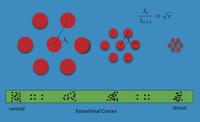 How do our brains make sense of a complex
and unpredictable world? In this talk, I will discuss a physicist's approach to
the neural topography of information processing in the brain. First I will review the brain's architecture, and how neural circuits map out the sensory
and cognitive worlds. Then I will describe how highly complex sensory and
cognitive tasks are carried out by the cooperative action of many specialized
neurons and circuits, each of which has a simple function. I will illustrate my
remarks with one sensory example and one cognitive example. For the sensory
example, I will consider the sense of smell ("olfaction"), whereby
humans and other animals distinguish vast arrays of odor mixtures using very
limited neural resources. For the cognitive example, I will consider the
"sense of place", that is, how animals mentally represent their
physical location. Both examples demonstrate that brains have evolved neural circuits
that exploit sophisticated principles of mathematics - principles that
scientists have only recently discovered.
How do our brains make sense of a complex
and unpredictable world? In this talk, I will discuss a physicist's approach to
the neural topography of information processing in the brain. First I will review the brain's architecture, and how neural circuits map out the sensory
and cognitive worlds. Then I will describe how highly complex sensory and
cognitive tasks are carried out by the cooperative action of many specialized
neurons and circuits, each of which has a simple function. I will illustrate my
remarks with one sensory example and one cognitive example. For the sensory
example, I will consider the sense of smell ("olfaction"), whereby
humans and other animals distinguish vast arrays of odor mixtures using very
limited neural resources. For the cognitive example, I will consider the
"sense of place", that is, how animals mentally represent their
physical location. Both examples demonstrate that brains have evolved neural circuits
that exploit sophisticated principles of mathematics - principles that
scientists have only recently discovered.

